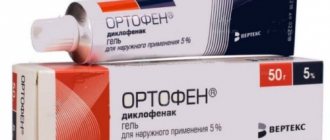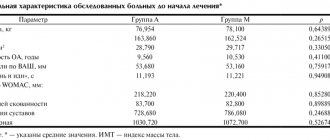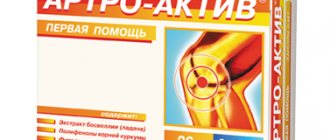Osterepar
Trade name: Osterepar International name: Alendronic acid Pharmacological group: bone resorption inhibitor - bisphosphonate Pharmacological group for ATC: M05BA04. Alendronic acid Pharmacological action: regulating phosphorus-calcium metabolism, reducing bone resorption of calcium, osteoporosis, treatment agent, stimulating osteogenesis Pharmacodynamics: Non-hormonal specific inhibitor of osteoclastic bone resorption (from the group of aminobisphosphonates - synthetic analogues of pyrophosphate, which binds hydroxyapatite found in bone), suppresses osteoclasts. Stimulates osteogenesis, restores a positive balance between bone resorption and restoration, progressively increases bone mineral density (regulates phosphorus-calcium metabolism), promotes the formation of normal bone tissue with normal histological structure.
Pharmacokinetics: Absorbed in the gastrointestinal tract 25%. Absolute bioavailability for tablets (10 mg) taken 2 hours before meals is 0.78% for women and 0.59% for men. Absolute bioavailability at a dose of 40 mg in women is 0.6%. When taken 30-60 minutes before meals, bioavailability is reduced by 40% compared to a dose taken 2 hours before meals. Taking 2 hours after a meal does not affect bioavailability; taking coffee and orange juice reduces bioavailability by 60%. Bonding with plasma proteins is about 78%. T1/2 is no more than 10 hours. Renal clearance is 71 ml/min, systemic - 200 ml/min. Plasma concentration after intravenous infusion decreases by 95% within 6 hours. It is excreted by the kidneys. Indications for use: Paget's disease, osteoporosis in postmenopausal women, hypercalcemia in malignant tumors. Contraindications: Hypersensitivity, pregnancy, lactation, childhood (safety and effectiveness have not yet been determined). With caution: Gastrointestinal diseases in the acute phase (dysphagia, esophagitis, gastritis, duodenitis, gastric ulcer and duodenal ulcer), esophageal stricture, esophageal achalasia, chronic renal failure (with CC less than 35 ml/min, the risk of drug accumulation increases), hypocalcemia, vitamin D deficiency.
Dosage regimen: Orally, 1 time per day, without chewing, 2 hours (at least 30 minutes) before the first meal, water or other drugs. Drink only plain water. For osteoporosis in postmenopausal women - 10 mg/day, for prevention - 5 mg/day. For Paget's disease - 40 mg/day for 6 months. Side effects: From the digestive system: abdominal pain, dysphagia, heartburn, esophagitis, ulcer or erosion of the esophagus, gastralgia, dyspepsia, flatulence, constipation or diarrhea, nausea. From the central nervous system: headache, irritability. From the skin: skin rash, skin hyperemia. Other: myalgia, asymptomatic hypocalcemia and hypophosphatemia.
Overdose: Treatment: milk or Ca2+-containing antacids to bind the drug (due to the risk of irritation of the esophagus, vomiting should not be induced). Interaction: Simultaneous use of Ca2+ drugs (including antacids) reduces absorption. The interval between taking the drug and other drugs should be at least 1 hour. Ranitidine increases bioavailability by 2 times (clinical significance has not been determined). NSAIDs enhance the adverse effects of alendronic acid. Special instructions: Take only plain water, since other drinks (including mineral water, coffee, tea, orange juice) reduce absorption. To reduce the irritating effect on the esophagus, it should be taken immediately after getting up in the morning with a full glass of water; after taking it, you should not lie down for 30 minutes (it is dangerous to use if the patient is unable to stand or sit straight for 30 minutes). Taking before bed or in a horizontal position increases the risk of developing esophagitis. If hypocalcemia is present, it must be corrected before starting treatment. Therapy should be combined with a diet enriched with Ca2+ salts.
Manufacturer: Polpharma Pharmaceutical Works SA, Poland Registration certificate holder: Polpharma Pharmaceutical Works SA, Poland Release form: tablets 70 mg, blister packs Composition: sodium alendronate trihydrate 91.36 mg [equiv. 70 mg alendronic acid] Dispensing conditions: by prescription Belongs to VED Shelf life: 2 years Registration data: LSR-007042/09 dated 09/07/2009 Status of the registration certificate: valid Pharmaceutical article number: LSR-007042/09-070909
Osterepar, 70 mg, tablets, 4 pcs.
The drug Osterepar®, like other bisphosphonates, can cause local irritation of the mucous membrane of the upper gastrointestinal tract. Patients receiving treatment with Osterepar® have experienced adverse reactions such as esophagitis, esophageal ulcers and esophageal erosions, rarely leading to strictures or perforation of the esophagus. In some cases, these adverse events can be severe and require hospitalization, so you should be especially careful to monitor any symptoms indicating possible problems with the esophagus. Patients should be warned of the need to stop taking Osterepar® and consult a doctor if dysphagia, pain when swallowing or behind the sternum, or heartburn appears or worsens.
The risk of severe esophageal adverse events is higher in patients who do not follow the drug dosage recommendations and/or continue to take the drug when symptoms of esophageal irritation occur. It is especially important that the patient has recommendations for taking the drug, understands them, and is informed that the risk of developing damage to the esophagus increases if these recommendations are not followed.
There are rare cases of stomach and duodenal ulcers, sometimes severe and complicated (a cause-and-effect relationship with taking the drug has not been established).
The drug Osterepar® should be prescribed with caution to patients with exacerbations of diseases of the upper gastrointestinal tract, such as dysphagia, diseases of the esophagus, gastritis, duodenitis and ulcers due to the possible irritant effect of the drug on the mucous membrane of the upper gastrointestinal tract and worsening of the underlying disease.
The decision to proceed with treatment must be made individually for each patient after a careful risk/benefit assessment, especially for patients with Barrett's esophagus.
There are cases of localized osteonecrosis of the jaw, associated mainly with previous tooth extraction and/or local infection (including osteomyelitis), often with slow recovery.
In most cases, bisphosphonate-associated osteonecrosis of the jaw occurs in cancer patients receiving IV bisphosphonates. Known risk factors for osteonecrosis of the jaw include cancer, concomitant therapies (eg, chemotherapy, radiation therapy, corticosteroids), poor oral hygiene and comorbidities (eg, periodontal and/or other dental diseases, anemia, coagulopathy, infection), and smoking. Patients who develop osteonecrosis of the jaw should receive specialized medical care from an oral and maxillofacial surgeon, and discontinuation of bisphosphonate therapy should be considered based on an individual assessment of the risk/benefit ratio. Dental surgery may worsen the condition.
The management of any patient requiring invasive dental procedures (eg, tooth extraction, implantation), including bisphosphonate therapy, should be based on the clinical judgment of the treating physician and/or oral surgeon and an individualized risk/benefit assessment.
Bone, joint and/or muscle pain has been reported in patients receiving bisphosphonates. These symptoms are rarely severe and/or disabling. The time until symptoms appear varies from one day to several months from the start of therapy. In most patients, symptoms subside when therapy is stopped, but in some patients, symptoms reappear when the same drug or another bisphosphonate is restarted.
Pathologic (ie, low-force or spontaneous) subtrochanteric or proximal femoral shaft fractures have been reported in a small number of patients taking bisphosphonates. Some of the fractures were classified as stress fractures (also known as stress fractures, marching fractures, and Deutschlander fractures), which occur in the absence of trauma. Some patients have experienced prodromal pain in the affected area for weeks or months before the onset of a complete fracture, often associated with the characteristic radiographic appearance of a stress fracture. The number of reports has been very small, and stress fractures with similar clinical features occur in patients not taking bisphosphonates. Patients with stress fractures should be evaluated for known causes and risk factors (eg, vitamin D deficiency, malabsorption, corticosteroid use, history of stress fracture, arthritis or lower extremity fracture, excessive or increased exercise, diabetes mellitus, chronic alcoholism) and provide they receive proper orthopedic care. Approximately one third of stress fractures were bilateral; Accordingly, in patients who have sustained a femoral shaft fracture, the contralateral hip should be examined. Pending evaluation results, consideration should be given to stopping bisphosphonates in patients with stress fractures based on a case-by-case assessment of the benefit/risk ratio.
Patients should be warned that if they accidentally miss taking Osterepar® once a week, they should take one tablet in the morning of the next day. You should not take two doses on the same day, but subsequently you should return to taking the drug once a week on the day of the week that was chosen at the beginning of treatment.
Causes of osteoporosis other than estrogen deficiency, age, and glucocorticoid treatment should be considered.
In the presence of hypocalcemia, the level of calcium in the blood must be normalized before starting treatment with Osterepar®. Other disorders of mineral metabolism (for example, vitamin D deficiency) should also be corrected. In patients with these disorders, it is necessary to monitor blood calcium levels and symptoms of hypocalcemia.
Since Osterepar® increases bone mineral content, a slight asymptomatic decrease in serum calcium and phosphate levels may be observed, especially in Paget's disease of bone, with an initially significantly increased bone turnover rate, as well as in patients receiving glucocorticoids, which is accompanied by possible decreased calcium absorption. It is especially important to ensure adequate calcium and vitamin D intake in these patients.
In rare cases, hypocalcemia can be severe, usually in patients with a predisposition to this complication (hypoparathyroidism, vitamin D deficiency, calcium malabsorption).
The drug contains lactose. Patients with lactase deficiency, galactose intolerance, and glucose-galactose malabsorption should refrain from using the drug.
Impact on the ability to drive vehicles and engage in other activities that require increased concentration and speed of psychomotor reactions
There is no data on the effect of the drug on the ability to drive a car or use other machinery. However, some side effects observed after taking alendronate may impair the ability to drive and operate machinery in some patients.
Osterepar®
The drug Osterepar®, like other bisphosphonates, can cause local irritation of the mucous membrane of the upper gastrointestinal tract. Patients receiving treatment with Osterepar® have experienced adverse reactions such as esophagitis, esophageal ulcers and esophageal erosions, rarely leading to strictures or perforation of the esophagus. In some cases, these adverse events can be severe and require hospitalization, so you should be especially careful to monitor any symptoms indicating possible problems with the esophagus. Patients should be warned of the need to stop taking Osterepar® and consult a doctor if dysphagia, pain when swallowing or behind the sternum, or heartburn appears or worsens.
The risk of severe esophageal adverse events is higher in patients who do not follow the drug dosage recommendations and/or continue to take the drug when symptoms of esophageal irritation occur. It is especially important that the patient has recommendations for taking the drug, understands them, and is informed that the risk of developing damage to the esophagus increases if these recommendations are not followed.
There are rare cases of stomach and duodenal ulcers, sometimes severe and complicated (a cause-and-effect relationship with taking the drug has not been established).
The drug Osterepar® should be prescribed with caution to patients with exacerbations of diseases of the upper gastrointestinal tract, such as dysphagia, diseases of the esophagus, gastritis, duodenitis and ulcers due to the possible irritant effect of the drug on the mucous membrane of the upper gastrointestinal tract and worsening of the underlying disease.
The decision to proceed with treatment must be made individually for each patient after a careful risk/benefit assessment, especially for patients with Barrett's esophagus.
There are cases of localized osteonecrosis of the jaw, associated mainly with previous tooth extraction and/or local infection (including osteomyelitis), often with slow recovery.
In most cases, bisphosphonate-associated osteonecrosis of the jaw occurs in cancer patients receiving IV bisphosphonates. Known risk factors for osteonecrosis of the jaw include cancer, concomitant therapies (eg, chemotherapy, radiation therapy, corticosteroids), poor oral hygiene and comorbidities (eg, periodontal and/or other dental diseases, anemia, coagulopathy, infection), and smoking. Patients who develop osteonecrosis of the jaw should receive specialized medical care from an oral and maxillofacial surgeon, and discontinuation of bisphosphonate therapy should be considered based on an individual assessment of the risk/benefit ratio. Dental surgery may worsen the condition.
The management of any patient requiring invasive dental procedures (eg, tooth extraction, implantation), including bisphosphonate therapy, should be based on the clinical judgment of the treating physician and/or oral surgeon and an individualized risk/benefit assessment. Bone, joint and/or muscle pain has been reported in patients receiving bisphosphonates. These symptoms are rarely severe and/or disabling. The time until symptoms appear varies from one day to several months from the start of therapy. In most patients, symptoms subside when therapy is stopped, but in some patients, symptoms reappear when the same drug or another bisphosphonate is restarted. Pathologic (ie, low-force or spontaneous) subtrochanteric or proximal femoral shaft fractures have been reported in a small number of patients taking bisphosphonates. Some of the fractures were classified as stress fractures (also known as stress fractures, marching fractures, and Deutschlander fractures), which occur in the absence of trauma. Some patients have experienced prodromal pain in the affected area for weeks or months before the onset of a complete fracture, often associated with the characteristic radiographic appearance of a stress fracture. The number of reports has been very small, and stress fractures with similar clinical features occur in patients not taking bisphosphonates. Patients with stress fractures should be evaluated for known causes and risk factors (eg, vitamin D deficiency, malabsorption, corticosteroid use, history of stress fracture, arthritis or lower extremity fracture, excessive or increased exercise, diabetes mellitus, chronic alcoholism) and provide they receive proper orthopedic care. Approximately one third of stress fractures were bilateral; Accordingly, in patients who have sustained a femoral shaft fracture, the contralateral hip should be examined. Pending evaluation results, consideration should be given to stopping bisphosphonates in patients with stress fractures based on a case-by-case assessment of the benefit/risk ratio.
Patients should be warned that if they accidentally miss taking Osterepar® once a week, they should take one tablet in the morning of the next day. You should not take two doses on the same day, but subsequently you should return to taking the drug once a week on the day of the week that was chosen at the beginning of treatment. Causes of osteoporosis other than estrogen deficiency, age, and glucocorticoid treatment should be considered.
In the presence of hypocalcemia, the level of calcium in the blood must be normalized before starting treatment with Osterepar®. Other disorders of mineral metabolism (for example, vitamin D deficiency) should also be corrected. In patients with these disorders, it is necessary to monitor blood calcium levels and symptoms of hypocalcemia.
Since Osterepar® increases bone mineral content, a slight asymptomatic decrease in serum calcium and phosphate levels may be observed, especially in Paget's disease of bone, with an initially significantly increased bone turnover rate, as well as in patients receiving glucocorticoids, which is accompanied by possible decreased calcium absorption. It is especially important to ensure adequate calcium and vitamin D intake in these patients.
In rare cases, hypocalcemia can be severe, usually in patients with a predisposition to this complication (hypoparathyroidism, vitamin D deficiency, calcium malabsorption).
The drug contains lactose. Patients with lactase deficiency, galactose intolerance, and glucose-galactose malabsorption should refrain from using the drug.




